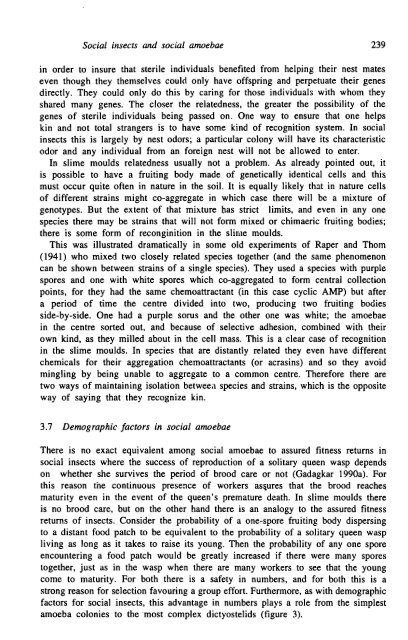Social insects and social amoebae. - Centre for Ecological Sciences
Social insects and social amoebae. - Centre for Ecological Sciences
Social insects and social amoebae. - Centre for Ecological Sciences
Create successful ePaper yourself
Turn your PDF publications into a flip-book with our unique Google optimized e-Paper software.
<strong>Social</strong> <strong>insects</strong> <strong>and</strong> <strong>social</strong> <strong>amoebae</strong> 239in order to insure that sterile individuals benefited from helping their nest mateseven though they themselves could only have offspring <strong>and</strong> perpetuate their genesdirectly. They could only do this by caring <strong>for</strong> those individual:; with whom theyshared many genes. The closer the relatedness, the greater the possibility of thegenes of sterile individuals being passed on. One way to ensure that one helpskin <strong>and</strong> not total strangers is to have some kind of recognition system. In <strong>social</strong><strong>insects</strong> this is largely by nest odors; a particular colony will have its characteristicodor <strong>and</strong> any individual from an <strong>for</strong>eign nest will not be allowed to enter.In slime moulds relatedness usually not a problem. As already pointed out, itis possible to have a fruiting body made of genetically identical cells <strong>and</strong> thismust occur quite often in nature in the soil. It is equally likely that in nature cellsof different strains might co-aggregate in which case there will be a mixture ofgenotypes. But the extent of that mixture has strict limits, <strong>and</strong> even in anyonespecies there may be strains that will not <strong>for</strong>m mixed or chimaeric fruiting bodies;there is some <strong>for</strong>m of reconginition in the slime moulds.This was illustrated dramatically in some old experiments of Raper <strong>and</strong> Thorn(1941) who mixed two closely related species together (<strong>and</strong> the same phenomenoncan be shown between strains of a single species). They used a species with purplespores <strong>and</strong> one with white spores which co-aggregated to <strong>for</strong>m central collectionpoints, <strong>for</strong> they had the same chemoattractant (in this case cyclic AMP) but aftera period of time the centre divided into two, producing two fruiting bodiesside-by-side. One had a purple sorus <strong>and</strong> the other one was white; the <strong>amoebae</strong>in the centre sorted out, <strong>and</strong> because of selective adhesion, combined with theirown kind, as they milled about in the cell mass. This is a clear case of recognitionin the slime moulds. In species that are distantly related they even have differentchemicals <strong>for</strong> their aggregation chemoattractants (or acrasins) <strong>and</strong> so they avoidmingling by being unable to aggregate to a common centre. There<strong>for</strong>e there aretwo ways of maintaining isolation betwee.l species <strong>and</strong> strains, which is the oppositeway of saying that they recognize kin.3.7 Demographic factors in <strong>social</strong> <strong>amoebae</strong>There is no exact equivalent among <strong>social</strong> <strong>amoebae</strong> to assured fitness returns in<strong>social</strong> <strong>insects</strong> where the success of reproduction of a solitary queen wasp dependson whether she survives the period of brood care or not (Gadagkar 1990a). Forthis reason the continuous presence of workers as~ures that the brood reachesmaturity even in the event of the queen's premature death, In slime moulds thereis no brood care, but on the other h<strong>and</strong> there is an analogy to the assured fitnessreturns of <strong>insects</strong>. Consider the probability of a one-spore fruiting body dispersingto a distant food patch to be equivalent to the probability of a solitary queen waspliving as long as it takes to raise its young. Then the probability of anyone sporeencountering a food patch would be greatly increased if there were many sporestogether, just as in the wasp when there are many workers to see that the youngcome to maturity. For both there is a safety in numbers, <strong>and</strong> <strong>for</strong> both this is astrong reason <strong>for</strong> selection favouring a group ef<strong>for</strong>t. Furthermore, as with demographicfactors <strong>for</strong> <strong>social</strong> <strong>insects</strong>, this advantage in numbers plays a role from the simplestamoeba colonies to the most complex dictyostelids (figure 3).
















